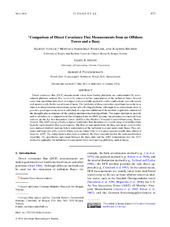Comparison of direct covariance flux measurements from an offshore tower and a buoy
Flügge, Martin; Bakhoday Paskyabi, Mostafa; Reuder, Joachim; Edson, James B.; Plueddemann, Albert J.
Peer reviewed, Journal article
Published version

View/
Date
2016-05Metadata
Show full item recordCollections
- Geophysical Institute [1198]
Original version
https://doi.org/10.1175/jtech-d-15-0109.1Abstract
Direct covariance flux (DCF) measurements taken from floating platforms are contaminated by wave-induced platform motions that need to be removed before computation of the turbulent fluxes. Several correction algorithms have been developed and successfully applied in earlier studies from research vessels and, most recently, by the use of moored buoys. The validation of those correction algorithms has so far been limited to short-duration comparisons against other floating platforms. Although these comparisons show in general a good agreement, there is still a lack of a rigorous validation of the method, required to understand the strengths and weaknesses of the existing motion-correction algorithms. This paper attempts to provide such a validation by a comparison of flux estimates from two DCF systems, one mounted on a moored buoy and one on the Air–Sea Interaction Tower (ASIT) at the Martha’s Vineyard Coastal Observatory, Massachusetts. The ASIT was specifically designed to minimize flow distortion over a wide range of wind directions from the open ocean for flux measurements. The flow measurements from the buoy system are corrected for wave-induced platform motions before computation of the turbulent heat and momentum fluxes. Flux estimates and cospectra of the corrected buoy data are found to be in very good agreement with those obtained from the ASIT. The comparison is also used to optimize the filter constants used in the motion-correction algorithm. The quantitative agreement between the buoy data and the ASIT demonstrates that the DCF method is applicable for turbulence measurements from small moving platforms, such as buoys.
